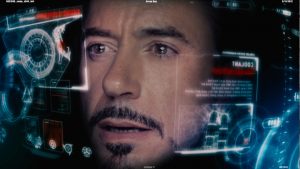- Augmented Reality (AR) technology and education. In the future, people will learn information based on AR technology rather than by text search engines such as Google. AR is an interactive experience of a real-world environment where the objects that reside in the real world are enhanced by computer-generated multimodal information, primarily visual and auditory. An example of this is the Iron Man’s suit. In Tony Stark’s helmet, the AR technology presented all information and analyses of the environment that he would need to fight better in the battleground
 . Similarly, people will run their searches using AR technology that will provide multimodal results and information, making the learning processes more meaningful. Portable AR devices, similar to phones, will be carried around with people and can overlay any required information onto the real world. If people search for anything like conducting a Google search, AR devices can show the results on the overlay. If people want to understand what an object is or how an object works, AR devices can show real-time information overlaid on the object. If people want to fix a problem, AR devices can show synchronous guidance to fix it. If people want to showcase anything, we can ask AR devices to project a manipulatable object on every participants’ information overlay. In a nutshell, people may learn and teach any idea in their mind without requiring much imagination or empathy.
. Similarly, people will run their searches using AR technology that will provide multimodal results and information, making the learning processes more meaningful. Portable AR devices, similar to phones, will be carried around with people and can overlay any required information onto the real world. If people search for anything like conducting a Google search, AR devices can show the results on the overlay. If people want to understand what an object is or how an object works, AR devices can show real-time information overlaid on the object. If people want to fix a problem, AR devices can show synchronous guidance to fix it. If people want to showcase anything, we can ask AR devices to project a manipulatable object on every participants’ information overlay. In a nutshell, people may learn and teach any idea in their mind without requiring much imagination or empathy.
- Super-teachers, AI raters, and virtual labs. In the future, teachers will shift from a teacher’s role to a facilitating role. In each school and classroom, there will be learning devices, similar to computers, for every learner. In a class, students will learn from pre-recorded videos, holograms, or other premade multimodal information sources that will be prepared by “super-teachers” – teachers that are nationally recognized for their teaching quality, communication ability, student performance, among others. Teachers in classrooms will be primarily responsible for discipline. Students will gain hands-on experiences in virtual labs using virtual manipulatable objects for subjects including biology, chemistry, physics, and etc. For example, a biopsy of any animal, including human beings, is not impractical or costly anymore if these are done with virtual animals on electronic devices without actually killing any animal. Student’s assignments will be graded by specially designed artificial intelligence that can provide every learner with immediate feedback. This new technology-enabled schooling offers every student equitable access to high-quality education and objective ratings. It also saves a significant amount of money due to the cut in school staff, teachers’ wages, material costs, and so forth.
 . Similarly, people will run their searches using AR technology that will provide multimodal results and information, making the learning processes more meaningful. Portable AR devices, similar to phones, will be carried around with people and can overlay any required information onto the real world. If people search for anything like conducting a Google search, AR devices can show the results on the overlay. If people want to understand what an object is or how an object works, AR devices can show real-time information overlaid on the object. If people want to fix a problem, AR devices can show synchronous guidance to fix it. If people want to showcase anything, we can ask AR devices to project a manipulatable object on every participants’ information overlay. In a nutshell, people may learn and teach any idea in their mind without requiring much imagination or empathy.
. Similarly, people will run their searches using AR technology that will provide multimodal results and information, making the learning processes more meaningful. Portable AR devices, similar to phones, will be carried around with people and can overlay any required information onto the real world. If people search for anything like conducting a Google search, AR devices can show the results on the overlay. If people want to understand what an object is or how an object works, AR devices can show real-time information overlaid on the object. If people want to fix a problem, AR devices can show synchronous guidance to fix it. If people want to showcase anything, we can ask AR devices to project a manipulatable object on every participants’ information overlay. In a nutshell, people may learn and teach any idea in their mind without requiring much imagination or empathy.